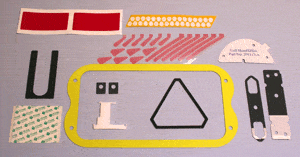
Diecut design hints and tips
The basics to bear in mind

Flatbed tooling uses a ribbon blade set in a composite block and is the more basic form of diecutting. It is relatively slow and only provides basic options, but the tooling is inexpensive. We use it for short runs, basic diecuts and prototypes.
Rotary tooling is ground from a solid steel cylinder by laser controlled equipment, then hardened. It is necessarily more expensive but has a long life and is more precise. It allows options such as dual height cutting and release options such as butterfly release, tabs and dry edges.
Your project specification
The information you need to provide to get the best result:
Product: We jointly need to agree the product that will be diecut. In many cases it is the product you are already using but if it is a new project please see the product selection guidelines on our web site.
Shape: If you don’t yet know the finished shape we can provide a guideline quote for the part based on the maximum dimensions, but we will need to confirm prices when we have a drawing from you. We can make tooling from existing parts or from sketches, but we strongly advise (and insist for rotary tooling) at least a .pdf with full dimensions. For best results on more complex parts we recommend a standard CAD format such as dwg, dwf, dxf, as the toolmaker can use this directly.
Cut-outs: If there are cut-outs within the diecut (holes, windows etc) please consider whether these waste parts can be left in, or whether they need to be removed (this requires more expensive tooling).
Application: Diecuts are normally supplied on a roll, and for use, the parts are taken off by hand with the top liner in place and applied to your component. If you are intending to use them any other way please tell us.
If you want to apply by machine or would like to discuss this option, please call us on 01628 642800.
